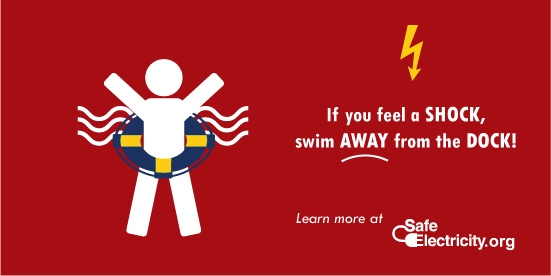Safety conscious parents insist their children wear life jackets around deep water, but parents and others need to be aware of a different kind of potentially deadly swimming danger: electric shock drowning. Electric current can unsuspectingly lurk in lakes or pools or anywhere electricity can bleed into water and its effects can range from a tingling sensation to paralyzed muscles to death.
In 2016, 15-year-old Carmen Johnson died when a ladder in the water near her family’s Alabama lake house carried an electric charge from a faulty light switch. In 2017, a 10-year-old girl died in a New Jersey lagoon after touching an electrically-charged metal boat lift rail. And those are only two of the many known or suspected cases of this lesser-known type of drowning called Electric Shock Drowning, or ESD.
Safe Electricity points out that electric shock drowning can happen when electricity from a dock, boat, pool, hot tub or marina escapes into the water due to faulty wiring or equipment. As swimmers enter electrified water, their muscles can become paralyzed and cause them to drown or they can suffer internal injuries or cardiac arrest. What’s more, someone not aware that electricity is flowing through the water could jump into the dangerous waters to try and rescue the person in distress and end up falling victim themselves.
Along with marina personnel, boat captains and owners also need to be diligent when it comes to the condition of boating-related electrical systems. “What was safe yesterday could be completely lethal today,” Rocky Pointe Marina general manager Jason Whitaker explained. “Boaters need to understand that this is a life or death issue and if their electrical system is not properly maintained or upgraded, it could mean somebody’s life,” he said. “Many people have died from an (electrical) fault” originating from a boat.
The majority of electric shock drowning deaths have occurred around marinas and docks with AC electrical power, both public and private, according to the Electric Shock Drowning Prevention Association (ESDPA). NEVER swim in or near marinas, docks or boatyards.
If you see what you think is an electric shock drowning:
- Turn the power source off at the breaker.
- Throw a life ring but do not enter the water (“reach, throw and row but do not go”).
- Call 9-1-1 or go look for help if no access to phone.
If you feel an electric shock, pulsing or other unusual sensations when you are in the water:
- Tuck your legs up close to your body; and
- Swim away from where you think the electricity might be coming from.
Due to conductivity properties of the human body, ESD occurs most often in fresh water. For more information about electrical safety, visit Safeelectricity.org.

